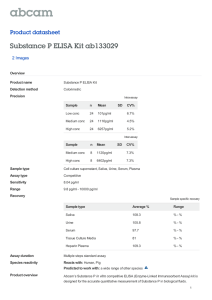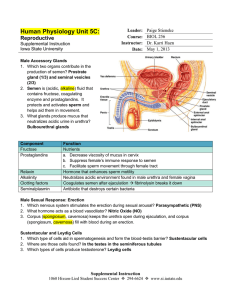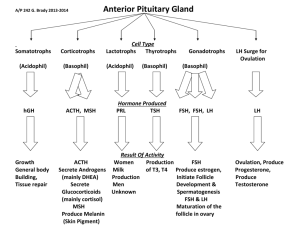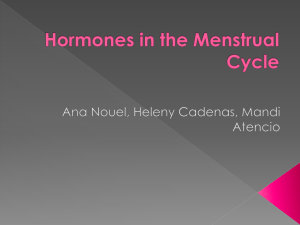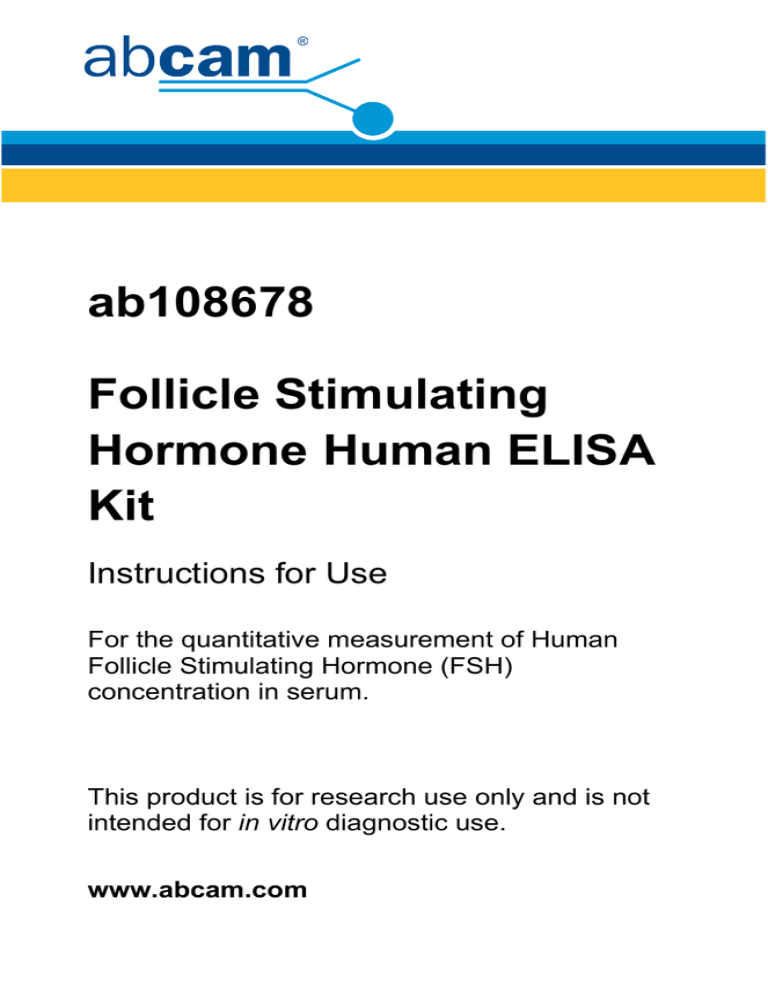
ab108678
Follicle Stimulating
Hormone Human ELISA
Kit
Instructions for Use
For the quantitative measurement of Human
Follicle Stimulating Hormone (FSH)
concentration in serum.
This product is for research use only and is not
intended for in vitro diagnostic use.
www.abcam.com
ab108678 Follicle Stimulating Hormone Human ELISA Kit
Table of Contents
1.
Introduction
2
2.
Assay Summary
3
3.
Kit Contents
4
4.
Storage and Handling
5
5.
Additional Materials Required
5
6.
Preparation of Reagents
6
7.
Preparation and Collection of Specimen
7
8.
Assay Method
8
9.
Data Analysis
11
10. Limitations
17
11. Specificity
19
12. Troubleshooting
20
1
ab108678 Follicle Stimulating Hormone Human ELISA Kit
1. Introduction
ab108678 Follicle Stimulating Hormone Human ELISA Kit is a
immunoenzymatic colorimetric method for quantitative determination
of Follicle Stimulating Hormone in serum.
Follicle Stimulating hormone (FSH) is a glycoprotein consisting of
two subunits with an approximate molecular mass of 35,500 daltons.
The α-subunit is similar to other pituitary hormones [luteinizing
stimulating hormone (LH), thyroid stimulating hormone (TSH) and
chorionic gonadotropin (hCG)] while the β-subunit is unique. The βsubunit confers the biological activity to the molecule. Stimulation by
gonadotropin-releasing hormone (GnRH) causes release of FSH, as
well as LH, from the pituitary and is transported by the blood to their
sites of action, the testes or ovary. In men, FSH acts on the Sertoli
cells of the testis, stimulating the synthesis of inhibin, which appears
to specifically inhibit further FSH secretion, and androgen-binding
protein. Thus, it indirectly supports spermatogenesis. In women,
FSH acts on the granulosa cells of the ovary, stimulating
steroidogensis. All ovulatory menstrual cycles have a characteristic
pattern of FSH, as well as LH, secretion.
2
ab108678 Follicle Stimulating Hormone Human ELISA Kit
2. Assay Summary
In the ab108678 method, calibrators, specimens and/or controls
(containing the native FSH antigen) are first added to streptavidin
coated wells.
Biotinylated monoclonal and horseradish peroxidase (HRP) labeled
antibodies are added and the reactants are mixed. The different
types of antibodies used have high affinity and specificity and are
directed against distinct and different epitopes of FSH. Reaction
between the various FSH antibodies and native FSH occurs in the
microwells without competition or steric hindrance, forming a soluble
sandwich complex.
Simultaneously, the complex is fixed to the well through the high
affinity reaction of streptavidin and biotinylated antibody. After
equilibrium is attained, the antibody-bound fraction is separated from
unbound antigen by aspiration.
The activity of the conjugated HRP is quantified by reaction with
TMB substrate to produce blue color. The reaction is terminated by
adding stop solution which turns the blue color into yellow. The
absorbance is measured on a plate reader.
3
ab108678 Follicle Stimulating Hormone Human ELISA Kit
3. Kit Contents
Coated Wells: 12 break apart 8-well snap-off strips coated with
Streptavidin, in resealable aluminium foil.
Stop Solution: 1 bottle containing 15 ml sulphuric acid,
0.15 mol/l (avoid any skin contact).
Anti-FSH conjugate: 1 bottle containing 12 ml of horseradish
peroxidase
labeled
anti-FSH
antibodies
(polyclonal)
and
biotinylated monoclonal anti-FSH antibodies.
TMB Substrate Solution: 1 bottle containing 15 ml 3, 3´, 5, 5´tetramethylbenzidine (H2O2-TMB 0.25g/l) (avoid any skin
contact).
Wash solution 50x conc.: 1 bottle containing 20 ml, 50 mM
phosphate buffer (pH 7.4, Tween20 1 g/l).
FSH Control: 1 bottle containing 1 ml of a lot-specific, ready to
use control. The concentration is mentioned on the label.
FSH Standards: 6 bottles, 1 ml each: The standards are
calibrated against the (WHO 2nd IRP 78/549) and have approx.
the following concentrations:
Standard 0: 0 mIU/ml
Standard 1: 5 mIU/ml
Standard 2: 10 mIU/ml
Standard 3: 25 mIU/ml
Standard 4: 50 mIU/ml
Standard 5: 100 mIU/ml
1 Strip holder
4
ab108678 Follicle Stimulating Hormone Human ELISA Kit
2 Cover foils
4. Storage and Handling
The closed reagents are stable up to the expiry date stated on the
label when stored at 2 - 8 °C in the dark. Opened reagents are stable
for 60 days when stored at 2 - 8°C.
5. Additional Materials Required
ELISA microwell plate reader, equipped for the measurement of
absorbance at 450 nm
Manual or automatic equipment for rinsing wells
Pipettes to deliver volumes between 50 μl (precision better than
1.5%)
Dispenser for repetitive deliveries of 100μl and 300 μl volumes
with a precision better than 1.5%
Vortex tube mixer
Distilled water
Quality control material
Timer
5
ab108678 Follicle Stimulating Hormone Human ELISA Kit
6. Preparation of Reagents
It is very important to bring all reagents, samples and standards
to room temperature (22-28°C) before starting the test run.
1.
Coated snap-off Strips: The ready to use break apart snap-off
strips are coated with Streptavidin. Store at 2-8°C. Open the
bag only when it is at room temperature. Immediately after
removal of strips, the remaining strips should be resealed in the
aluminium foil along with the desiccant supplied and stored at 28°C. Do not remove the adhesive sheets on the unused strips.
2.
Anti-FSH Conjugate: The bottle contains 13 ml of a ready-touse conjugate mixture of HRP-labeled polyclonal anti-FSH
antibodies and biotinylated monoclonal anti-FSH antibodies.
3.
FSH Standards: Each of the 6 vials contains 1 ml standard
solution of the concentration mentioned in Kit Contents. The
standards are ready to use.
4.
TMB Substrate Solution: The bottle contains 12 ml of a
tetramethylbenzidine/hydrogen peroxide system. The reagent is
ready to use and has to be stored at 2-8°C in the dark. The
solution should be colorless or could have a slight blue tinge. If
the substrate turns into blue, it may have become contaminated
and should be thrown away. After first use the TMB substrate
solution is still stabile for another 6 months if stored at 2-8 °C.
6
ab108678 Follicle Stimulating Hormone Human ELISA Kit
5.
Stop Solution: The bottle contains 12 ml 0.15 M sulphuric acid
solution (R 36/38, S 26). This ready to use solution has to be
stored at 2-8°C. After first use stable until expiry date.
6.
Wash Solution: Dilute the 50x concentrated wash solution to
1000 ml with distilled or deionised water in a suitable storage
container.
7. Preparation and Collection of Specimen
Use human serum as samples with this assay. The blood should be
collected in a venipuncture tube without additives or anticoagulants.
Allow the blood to clot. Centrifuge the specimen to separate the
serum from the cells.
Samples may be refrigerated at 2-8°C for a maximum period of 5
days. If the specimen(s) cannot be assayed within this time, the
sample(s) may be stored at temperatures of -20°C for up to 30 days.
Avoid repetitive freezing and thawing.
For accurate comparison to established normal values, a fasting
morning serum sample should be obtained.
Precaution:
The reagents contain Proclin 300® as preservative
Do not use heavily haemolysed or highly lipemic samples.
7
ab108678 Follicle Stimulating Hormone Human ELISA Kit
Maximum
precision
is
required
for
reconstitution
and
dispensation of the reagents.
This method allows the determination of FSH from 0.6 to
100 mIU/ml.
8. Assay Method
Test Preparation
Please read the test protocol carefully before performing the assay.
Result reliability depends on strict adherence to the test protocol as
described. Prior to commencing the assay, the distribution and
identification plan for all specimens and standards should be
carefully established. Select the required number of microtiter strips
or wells and insert them into the holder. Pipetting of samples should
not extend beyond ten minutes to avoid assay drift. If more than one
plate is used, it is recommended to repeat the dose response curve.
Please allocate at least:
1 well
2 wells
2 wells
2 wells
2 wells
2 wells
2 wells
2 wells
(e.g. A1)
(e.g. B1+C1)
(e.g. D1+E1)
(e.g. F1+G1)
(e.g. H1+A2)
(e.g. B2+C2)
(e.g. D2+E2)
(e.g. F2+G2)
for the substrate blank
for standard 0
for standard 1
for standard 2
for standard 3
for standard 4
for standard 5
for control
8
ab108678 Follicle Stimulating Hormone Human ELISA Kit
It is recommended to determine standards and samples in duplicate.
Perform all assay steps in the order given and without any
appreciable delays between the steps.
A clean, disposable tip should be used for dispensing each standard
and each sample.
Assay Procedure:
1. Dispense 50 μl standards and samples into their respective
wells. Add 100 μl conjugate to each well. Leave well A1 for
substrate blank.
2. Cover wells with the foil supplied in the kit.
3. Incubate for 1 hour at room temperature (22 – 28 °C).
4. When incubation has been completed, remove the foil, aspirate
the content of the wells and wash each well three times with 300
μl diluted wash solution. Avoid overflows from the reaction wells.
The soak time between each wash cycle should be >5sec. At the
end carefully remove remaining fluid by tapping strips on tissue
paper prior to the next step!
Note: Washing is critical! Insufficient washing results in poor
precision and falsely elevated absorbance values
5. Dispense 100 μl TMB Substrate Solution into all wells.
6. Incubate for exactly 15 min at room temperature (22 – 28°C)
in the dark.
9
ab108678 Follicle Stimulating Hormone Human ELISA Kit
7. Dispense 100 μl Stop Solution into all wells in the same order
and at the same rate as for the TMB Substrate Solution.
Any blue color developed during the incubation turns into yellow.
8. Measure the absorbance of the specimen at 450 nm within 30
min after addition of the Stop Solution.
Measurement:
Adjust the ELISA Microwell Plate Reader to zero using the
substrate blank in well A1.
If - due to technical reasons - the ELISA reader cannot be adjusted
to zero using the substrate blank in well A1, subtract the absorbance
value of well A1 from all other absorbance values measured in order
to obtain reliable results!
Measure the absorbance of all wells at 450 nm and record the
absorbance values for each standard and sample.
Where applicable calculate the mean absorbance values of all
duplicates.
Quality control:
Each laboratory should assay controls at normal, high and low levels
range of FSH for monitoring assay performance. These controls
should be treated as unknowns and values determined in every test
10
ab108678 Follicle Stimulating Hormone Human ELISA Kit
procedure performed. Quality control charts should be maintained to
follow the performance of the supplied reagents. Pertinent statistical
methods should be employed to ascertain trends. The individual
laboratory should set acceptable assay performance limits. In
addition, maximum absorbance should be consistent with past
experience. Significant deviation from established performance can
indicate unnoticed change in experimental conditions or degradation
of kit reagents. Fresh reagents should be used to determine the
reason for the variations.
If computer controlled data reduction is used to calculate the results
of the test, it is imperative that the predicted values for the calibrators
fall within 10% of the assigned concentrations.
9. Data Analysis
A.
Validity of the assay
The optical density (OD) of standard 5 should be ≥ 1.3
B.
OD Conversion
The optical densities (O.D.) of some standards and samples may be
higher than 2.0, in such a case, they could be out of the
measurement range of the microplate reader. It is therefore
necessary, for O.D.s higher than 2.0, to perform a reading at 405
11
ab108678 Follicle Stimulating Hormone Human ELISA Kit
nm (=wavelength of peak shoulder) in addition to 450 nm (peak
wavelength) and 620 (reference filter for the subtraction of
interferences due to the plastic).
For microplate readers unable to read the plate at 3 wavelengths at
the same time, it is advisable to proceed as follows:
- Read the microplate at 450 nm and at 620 nm.
- Read again the plate at 405 nm and 620 nm.
- Find out the wells whose ODs at 450 nm are higher than 2.0
- Select the corresponding ODs read at 405 nm and multiply these
values at 405 nm by the conversion factor 3.0 (where OD 450/OD
405 = 3.0), that is: OD 450 nm = OD 405 nm x 3.0
Warning: The conversion factor 3.0 is suggested only. For better
accuracy, the user is advised to calculate the conversion factor
specific for his own reader.
C.
Calculation
Automated method
Use the 4 parameter logistic (preferred) or the smoothed cubic spline
function as calculation algorithm.
Manual method
A dose response curve is used to ascertain the concentration of
follicle stimulating hormone in unknown specimens.
12
ab108678 Follicle Stimulating Hormone Human ELISA Kit
1. Record the OD obtained from the printout of the microplate
reader as outlined in Example 1.
2. Plot
the
OD
for
each
duplicate
calibrator
versus
the
corresponding FSH concentration in mIU/ml on linear graph
paper (do not average the duplicates of the serum references
before plotting).
3. Draw the best-fit curve through the plotted points.
4. To determine the concentration of FSH for an unknown, locate
the average OD of the duplicates for each unknown on the
vertical axis of the graph, find the intersecting point on the curve,
and read the concentration (in mIU/ml) from the horizontal axis
of the graph (the duplicates of the unknown may be averaged).
NOTE: The data presented in Example 1 are for illustration only and
should not be used in lieu of a standard curve prepared with each
assay. Assigned values for standards are lot specific.
13
ab108678 Follicle Stimulating Hormone Human ELISA Kit
Example 1
Sample ID
Well
OD
Mean OD
number
Standard 0
Standard 1
Standard 2
Standard 3
Standard 4
Standard 5
Control
Sample
Value
mIU/ml
A1
0.092
B1
0.053
C1
0.375
D1
0.367
E1
0.573
F1
0.588
G1
1.412
H1
1.190
A2
1.923
B2
1.965
C2
2.739
D2
2.650
E2
0.714
F2
0.6881
G2
1.671
H2
1.496
0.072
0
0.371
5
0.581
10
1.301
25
1.944
50
2.694
100
0.697
13.89
1.627
43.8
14
ab108678 Follicle Stimulating Hormone Human ELISA Kit
D.
Reference Values
Each laboratory must establish its own normal ranges based on
population.
The serum or plasma FSH values are comprised in the following
intervals:
Sample
Range mIU/ml
Male
1-4
Female:
Follicular phase
3 - 12
Midcycle
8 - 22
Luteal phase
2 – 12
Menopausal
35 - 151
It is important to keep in mind that establishment of a range of values
which can be expected to be found by a given method for a
population of “normal” persons is dependent upon a multiplicity of
factors: the specificity of the method, the population tests and the
precision of the method in the hands of the analyst.
For these reasons each laboratory should depend upon the range of
expected values established by the Manufacturer only until an in
house range can be determined by the analyst using the method
15
ab108678 Follicle Stimulating Hormone Human ELISA Kit
with a population indigenous to the area in which the laboratory is
located.
E.
Sensitivity
The lowest detectable concentration of FSH by this assay is
0.6 mIU/ml.
F.
Reproducibility
Intra-Assay: Within-run precision was determined by replicate
determinations of three different control sera in one assay. The
within assay variability is shown.
Serum Sample
1
2
3
Number of Replicates
20
20
20
Mean FSH (mIU/ml)
5.4
15.6
37.9
Standard Deviation
0.46
1.32
3.56
Coefficient of Variation
(%)
9.6
8.5
9.4
16
ab108678 Follicle Stimulating Hormone Human ELISA Kit
Inter-Assay: Between-run precision was determined by replicate
measurements of three different control sera in several different
assays. The between assay variability is shown below.
Serum Sample
1
2
3
Number of Replicates
10
20
20
Mean FSH (mIU/ml)
5.9
16.9
35.3
Standard Deviation
0.66
1.59
4.16
Coefficient of Variation
(%)
11.2
9.4
11.8
10. Limitations
Procedural directions must be followed exactly and careful
technique must be used to obtain valid results. Any modification
of the procedure is likely to alter the results. FSH is dependent
upon diverse factors other than pituitary homeostasis.
FSH is suppressed by estrogen but in woman taking
contraceptives the level may be low or normal. Excessive
dieting and weight loss may lead to low gonadotropin
concentration.
Specimens with abnormally high FSH levels can cause a hook
effect, that is, paradoxical low absorbance results. If this is
17
ab108678 Follicle Stimulating Hormone Human ELISA Kit
suspected, dilute the specimen 1/100 with standard 0, re-assay
(multiply the result by 100). However, values as high as 2000
mIU/ml have been found to absorb greater than the absorbance
of the highest calibrator.
Those receiving preparations of mouse monoclonal antibodies
for diagnosis of therapy may contain human anti-mouse
antibodies (HAMA) and may show either falsely elevated or
depressed values when assayed.
Samples with an expected FSH concentration of > 100 mIU/ml
should be diluted with standard 0 before testing.
18
ab108678 Follicle Stimulating Hormone Human ELISA Kit
11. Specificity
The cross-reactivity of ab108678 Follicle Stimulating Hormone
Human ELISA Kit to selected substances was evaluated by adding
the
interfering
substance
to
a
serum
matrix
at
various
concentrations. The cross-reactivity was calculated by deriving a
ratio between dose of interfering substance to dose of Follicle
Stimulating Hormone needed to produce the same OD.
Material Tested
Cross Reactivity
Concentration
Follitropin (FSH)
1.0000
---
Lutropin Hormone (hLH)
<0.0001
1000ng/ml
Chorionic Gonadotropin (hCG)
<0.0001
1000ng/ml
Tireotropin (TSH)
<0.0001
1000ng/ml
19
ab108678 Follicle Stimulating Hormone Human ELISA Kit
12. Troubleshooting
Problem
Cause
Solution
Poor standard
curve
Improper standard dilution
Confirm dilutions made
correctly
Standard improperly
reconstituted (if
applicable)
Briefly spin vial before
opening; thoroughly
resuspend powder (if
applicable)
Standard degraded
Store sample as
recommended
Curve doesn't fit scale
Try plotting using different
scale
Incubation time too short
Try overnight incubation at
4 °C
Target present below
detection limits of assay
Decrease dilution factor;
concentrate samples
Precipitate can form in
wells upon substrate
addition when
concentration of target is
too high
Increase dilution factor of
sample
Using incompatible
sample type (e.g. serum
vs. cell extract)
Detection may be reduced
or absent in untested
sample types
Sample prepared
incorrectly
Ensure proper sample
preparation/dilution
Bubbles in wells
Ensure no bubbles
present prior to reading
plate
Low signal
Large CV
20
ab108678 Follicle Stimulating Hormone Human ELISA Kit
High
background
Low sensitivity
All wells not washed
equally/thoroughly
Check that all ports of
plate washer are
unobstructed/wash wells
as recommended
Incomplete reagent mixing
Ensure all
reagents/master mixes
are mixed thoroughly
Inconsistent pipetting
Use calibrated pipettes
and ensure accurate
pipetting
Inconsistent sample
preparation or storage
Ensure consistent sample
preparation and optimal
sample storage conditions
(e.g. minimize
freeze/thaws cycles)
Wells are insufficiently
washed
Wash wells as per
protocol recommendations
Contaminated wash buffer
Make fresh wash buffer
Waiting too long to read
plate after adding STOP
solution
Read plate immediately
after adding STOP
solution
Improper storage of
ELISA kit
Store all reagents as
recommended. Please
note all reagents may not
have identical storage
requirements.
Using incompatible
sample type (e.g. Serum
vs. cell extract)
Detection may be reduced
or absent in untested
sample types
For further technical questions please do not hesitate to
contact us by email (technical@abcam.com) or phone (select
“contact us” on www.abcam.com for the phone number for
your region).
21
ab108678 Follicle Stimulating Hormone Human ELISA Kit
22
ab108678 Follicle Stimulating Hormone Human ELISA Kit
Abcam in the USA
Abcam Inc
1 Kendall Square, Ste B2304
Cambridge,
MA 02139-1517
USA
Toll free: 888-77-ABCAM (22226)
Fax: 866-739-9884
Abcam in Europe
Abcam plc
330 Cambridge Science Park
Cambridge
CB4 0FL
UK
Tel: +44 (0)1223 696000
Fax: +44 (0)1223 771600
Abcam in Japan
Abcam KK
1-16-8 Nihonbashi
Kakigaracho,
Chuo-ku, Tokyo
103-0014
Japan
Tel: +81-(0)3-6231-094
Fax: +81-(0)3-6231-0941
Abcam in Hong Kong
Abcam (Hong Kong) Ltd
Unit 225A & 225B, 2/F
Core Building 2
1 Science Park West Avenue
Hong Kong Science Park
Hong Kong
Tel: (852) 2603-682
Fax: (852) 3016-1888
23
Copyright © 2011 Abcam, All Rights Reserved. The Abcam logo is a registered trademark.
All information / detail is correct at time of going to print.

